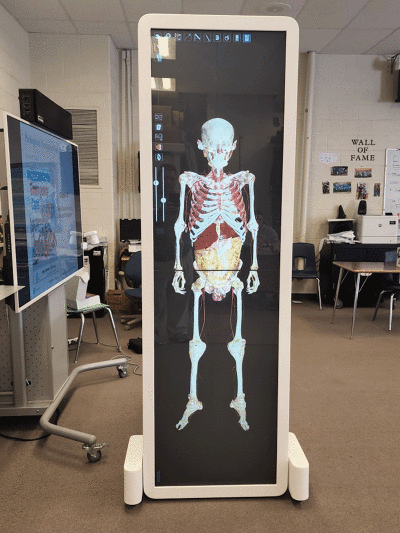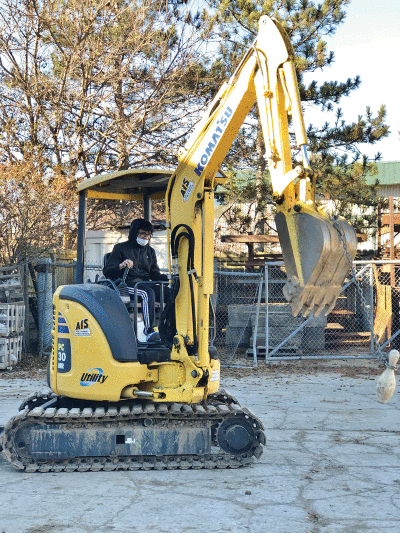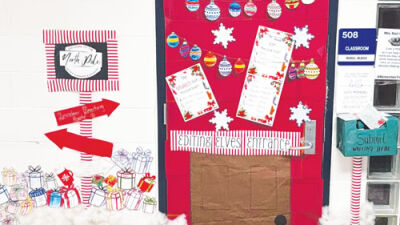
The Anatomage Table is a human 3D anatomy system that allows for students to explore the human anatomy. The 3D table is used in medical schools and is an alternative to using cadavers for educational purposes.
Photo provided by Christine Akroush

A new class called “heavy equipment operation and repair” is now offered in the Industry, Technology and Innovation Academy at Center Line High School.
Photo provided by Christine Akroush
CENTER LINE — Students in two separate programs at Center Line High School started the 2022-2023 school year with new opportunities.
This year, school officials are offering a new class called “heavy equipment operation and repair” in its Industry, Technology and Innovation Academy. The two-hour block class is for students interested in learning how to operate heavy machinery.
Students in the emergency medical services program are getting more hands-on experience with the new 3D anatomy/virtual dissection tool Anatomage Table. EMS is part of the school’s Health & Human Services Academy. Anatomage is a medical equipment manufacturer in Santa Clara, California. The table was delivered during the last school year, and this is the first full year it will be used. Grant money made the new equipment possible.
“This grant focuses on obtaining the latest technology by providing funding so that classrooms are able to get a piece of equipment they are using in industry that we wouldn’t otherwise get,” a Center Line Public Schools press release stated. “With the help of the grant and the district supplementing the remaining amount we were able to make this possible.”
Both classes are Career & Technical Education courses offered through the Southwest Macomb Technical Educational Consortium in which students from various high schools can attend these classes at Center Line High School.
Heavy Equipment Operation and Repair
The new heavy equipment class, taught by teacher Ted Olson, came about to train a new generation of skilled workers. AIS Construction Equipment Corp., headquartered in Lansing with other locations, formed a partnership with the district to offer the class. The company has teachers in six different districts.
“Our goal is to expose them to this industry. The equipment is so technically advanced and the students need a really strong background,” Olson said. “There is a high need for technicians and operators. The workforce is aging out, and employees are looking for good people.”
In the program, the students will study engineering, electronics, precision measuring, tools and more. They also will learn to properly operate utility tractors, vertical mast forklifts, backhoe simulators, excavators, bulldozers and front-end loaders. The students will do bookwork and hands-on work in class.
So far, this is just one heavy equipment class at Center Line. Olson also teaches the class in Richmond. Some of the equipment will be delivered to the high school as needed. About once a month, the students will head to the Richmond-area AIS location to have access to more resources.
“We’ll also expose them to welding in this class,” Olson said. “There are so many opportunities in this industry.”
Those opportunities include working in electronics, construction, demolition and forestry. Olson has plans to bring in guest speakers from the industry to talk to the students about their experiences.
“I hope the program grows,” Olson said. “We’re finding a lot of kids want to be operators as opposed to technicians.”
Once completed, the students will have earned Level 1 certification with the National Center for Construction Education and Research.
“It shows potential,” Olson said. “They have some background in this.”
He said Level 2 and Level 3 can be earned after high school.
Anatomage Table
The Anatomage Table is a human 3D anatomy system that allows for students to explore the human anatomy. The 3D table is used in medical schools and is an alternative to using cadavers for educational purposes.
There are four different cadavers within the 3D table. The cadavers were real people; two of them are men, one Asian and one Caucasian, and two are women, one Asian and one Caucasian. The table is a Windows-based computer, and the technology tool is designed to enhance classroom learning by providing a visual hands-on experience.
“With this, I can get 10-15 students around at a time. It’s meant to teach people how the body works and what it does. They micro sliced them and, each slice, they photograph,” Center Line High School EMS and firefighting teacher Dave Watts said. “Once I take the skin off, you can see everything. We can look at the muscle system. We can see how vivid this is, how clear this is. I can keep pulling off layer by layer.
“You’ll start to see all the organs and the skeleton. You can see all the veins. You can see the arteries. You see the lungs, liver, stomach, some fat tissue,” Watts said. “If I do a lesson on the heart, I can show them how the cardiovascular system works. This changes the way anatomy is taught.”
The table is used in either a vertical or a horizontal format. Watts said that the EMS students will use the 3D table in class.
“If you’re going to be out there transporting people, you better know how the disease processes work,” Watts said. “EMS itself is changing. Because of our increased demand in health care, we are expected to diagnose on the road (more) than we ever have been. The hospital can treat that patient twice as fast. EMS is now part of the continuum of care.”
The anatomy students and ninth grade biology students will use the table, which can easily be transported.
“This table is loaded with almost 1,400 case studies. They’re all X-rays, CT scans and MRIs of all the different disease processes,” Watts said. “Instead of telling and teaching, now we’re showing and doing.”
 Publication select ▼
Publication select ▼





















